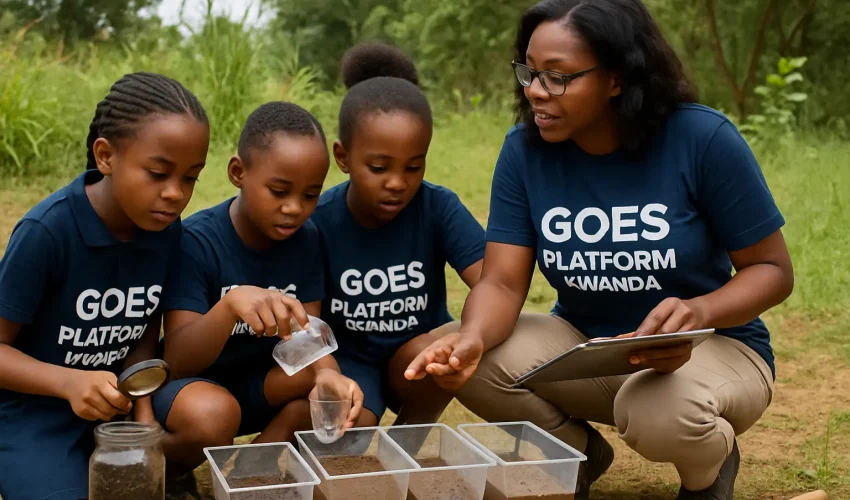P4 Science and Elementary Technology (SET)

Get unlimited access to all learning content and premium assets Membership Pro
⚙️ P4 Science and Elementary Technology (SET)
Welcome to the Primary 4 Science and Elementary Technology Program!
This course introduces learners to the wonders of science and technology through hands-on exploration, observation, and practical activities. Designed to spark curiosity, it helps children understand their environment while building a foundation for critical thinking, creativity, and problem-solving.
From learning about plants, animals, and the human body to experimenting with materials, tools, and simple machines, learners discover how science and technology shape their daily lives. This program also integrates real-world examples to make lessons meaningful and engaging.
📘 What Learners Will Explore:
- Basic carpentry, masonry, and object production skills
- Introduction to computer skills and responsible use of technology
- Water and soil: sources, uses, and conservation
- Animals and plants: classification, care, and importance
- The human digestive and reproductive systems
- Light and electricity: simple experiments and applications
- Materials and their properties in everyday life
🧠 The 4Cs in Action:
- Critical Thinking: Investigating natural phenomena and solving practical problems.
- Creativity: Designing simple models and using tools to create objects.
- Communication: Sharing observations and presenting group findings.
- Collaboration: Working together on science experiments and technology projects.
- 12 Sections
- 102 Lessons
- 10 Weeks
- Unit 1: Objects ProductionIn this unit, you will learn how to make different objects using local materials such as wires, clay, sticks, and banana fibres. You will practice creativity by making toys and simple utility items. You will also learn how to take care of the things you make and understand why maintaining them is important.7
- 1.1Lesson 1: Introduction to Objects Production
- 1.2Lesson 2: Making Toys Using Wires
- 1.3Lesson 3: Making Toys Using Clay
- 1.4Lesson 4: Making Utility Objects Using Sticks
- 1.5Lesson 5: Making Utility Objects Using Banana Fibres
- 1.6Lesson 6: Maintenance of Utilities and Learning Objects
- 1.7Lesson 7: Review & End of Unit Assessment (Unit 1 P4 SET)
- Unit 2: ICT BasicsHere, you will be introduced to the basic concepts of Information and Communication Technology. You will learn about digital and analogue data, computer hardware and software, and how to use storage devices like flash disks. You will also explore the use of journals and internet terms that are useful in daily computer work.8
- Unit 3: Graphics and MultimediaIn this unit, you will explore how to create and edit pictures using the Paint application. You will learn about freehand drawing, using shapes, and understanding the Paint environment. You will also discover multimedia and its uses in communication and learning.7
- Unit 4: Programming for ChildrenHere, you will learn how to use simple programming tools like Turtle Art and Scratch. You will practice opening, saving, and creating projects to draw shapes and make animations. You will also be introduced to robotics and discover how programming helps us solve problems creatively.9
- 4.1Lesson 1: Introduction to Programming for Children
- 4.2Lesson 2: Opening, Saving and Closing Turtle Blocks
- 4.3Lesson 4: Drawing Shapes Using Turtle Art
- 4.4Lesson 5: Opening, Saving and Closing Projects in Scratch
- 4.5Lesson 3: Elements of the Turtle Art Window
- 4.6Lesson 6: Making Animations in Scratch
- 4.7Lesson 7: Adding and Coding a Background in Scratch
- 4.8Lesson 8: Introduction to Robotics
- 4.9Lesson 9: Review & End of Unit Assessment
- Unit 5: Air, Wind and SoundIn this unit, you will study the main properties and composition of air and understand its uses and dangers. You will learn about wind, its types, and how it affects our environment. You will also explore how sound is produced, how it travels, and how to protect your ears from noise.12
- 5.1Lesson 1: Introduction to Air, Wind and Sound
- 5.2Lesson 2: Main Properties of Air
- 5.3Lesson 3: Composition of Air
- 5.4Lesson 4: Dangers of Components of Air
- 5.5Lesson 5: Wind and Its Types
- 5.6Lesson 6: Uses of Air and Wind
- 5.7Lesson 8: Nature and Production of Sound
- 5.8Lesson 9: Propagation and Reflection of Sound
- 5.9Lesson 7: Dangers of Wind and Their Prevention
- 5.10Lesson 10: Noise and Its Effects
- 5.11Lesson 11: Protection of Ears from Noise
- 5.12Lesson 12: Review & End of Unit Assessment
- Unit 6: SoilHere, you will learn what soil is, its different types, and what it is made of. You will discover how soil supports plant growth, and why fertile soil is important for farming. You will also learn about soil erosion, its causes, and ways to prevent it.9
- 6.1Lesson 1: Introduction to Soil
- 6.1Lesson 3: Composition of Soil
- 6.2Lesson 2: Definition and Types of Soil
- 6.3Lesson 4: Uses of Soil
- 6.4Lesson 5: Characteristics of Fertile Soil
- 6.5Lesson 7: Types of Erosion
- 6.6Lesson 6: Soil Erosion and Its Causes
- 6.7Lesson 8: Prevention of Soil Erosion
- 6.8Lesson 9: Review & End of Unit Assessment
- Unit 7: Animals ClassificationIn this unit, you will learn how to identify and classify animals based on features such as their backbone, how they move, breathe, feed, and reproduce. You will understand the differences between animals and appreciate the diversity of life in your environment.8
- 7.1Lesson 1: Introduction to Animal Classification
- 7.2Lesson 2: Identification of Various Animals
- 7.3Lesson 3: Classification of Animals by Backbone
- 7.4Lesson 4: Classification of Animals by Respiration Mode
- 7.5Lesson 6: Classification of Animals by Feeding Mode
- 7.6Lesson 7: Classification of Animals by Reproductive Mode
- 7.7Lesson 5: Classification of Animals by Locomotion Mode
- 7.8Lesson 8: Review & End of Unit Assessment
- Unit 8: Rabbits and Chickens ManagementHere, you will study how to care for rabbits and chickens. You will learn about their shelters, feeding habits, and common diseases. You will also discover why raising these animals is useful for food, income, and practical skills in animal care.14
- 8.1Lesson 1: Introduction to Rabbits and Chickens Management
- 8.2Lesson 2: Conditions of a Good Rabbit Hutch
- 8.3Lesson 3: Characteristics of Good Rabbits
- 8.4Lesson 4: Criteria for Choosing a Rabbit to Rear
- 8.5Lesson 6: Rabbit Health and Common Diseases
- 8.6Lesson 7: Importance of Rabbit Farming
- 8.7Lesson 5: Proper Feeding of Rabbits
- 8.8Lesson 9: Types of Chicken Breeds
- 8.9Lesson 8: Conditions of a Good Chicken House
- 8.10Lesson 10: Reproduction of Chickens
- 8.11Lesson 11: Proper Feeding of Chickens
- 8.12Lesson 13: Importance and Process of Chicken Farming
- 8.13Lesson 12: Chicken Diseases and Their Prevention
- 8.14Lesson 14: Review & End of Unit Assessment
- Unit 9: Plants GerminationIn this unit, you will learn about how seeds germinate and the conditions they need to grow. You will observe the stages of germination and study the parts of a plant. You will also understand how each part functions to keep the plant alive and healthy.7
- Unit 10: Human Sensory OrgansHere, you will explore the five senses and learn how each organ works. You will study the functions of the skin, tongue, nose, ears, and eyes, and learn how to take care of them. You will understand how the senses help you interact safely with your environment.8
- 10.1Lesson 1: Introduction to Human Sensory Organs
- 10.2Lesson 2: Functional Mechanism of All Sensory Organs
- 10.3Lesson 4: Function and Maintenance of Tongue
- 10.4Lesson 5: Function and Maintenance of Nose
- 10.5Lesson 6: Function and Maintenance of Ear
- 10.6Lesson 3: Function and Maintenance of Skin
- 10.7Lesson 8: Review & End of Unit Assessment
- 10.8Lesson 7: Function and Maintenance of Eye
- Unit 11: Human SkeletonIn this unit, you will learn about the main parts and major bones of the human skeleton. You will understand how bones support and protect the body, and how joints allow movement. You will also learn simple ways of caring for your skeleton.6
- Unit 12: MusclesHere, you will learn about the different types of muscles in your body and their functions. You will study how muscles help in movement and how to care for them. You will also learn about muscle cramps and basic first aid to handle them safely.7
- 12.1Lesson 1: Introduction to Muscles
- 12.2Lesson 2: Definition and Types of Muscles
- 12.3Lesson 4: Functions of Voluntary Muscles
- 12.4Lesson 5: Muscle Accidents (Cramps) and First Aid
- 12.5Lesson 3: Major Muscle Groups
- 12.6Lesson 6: Caring and Maintaining Muscles
- 12.7Lesson 7: Review & End of Unit Assessment
Get unlimited access to all learning content and premium assets Membership Pro
"The P4 Science and Technology course made learning exciting for my child. She enjoyed the experiments, and now she explains how plants grow and how electricity works with so much confidence!" — Parent of a Primary 4 learner
You might be interested in
-
All levels
-
2 Students
-
39 Lessons



